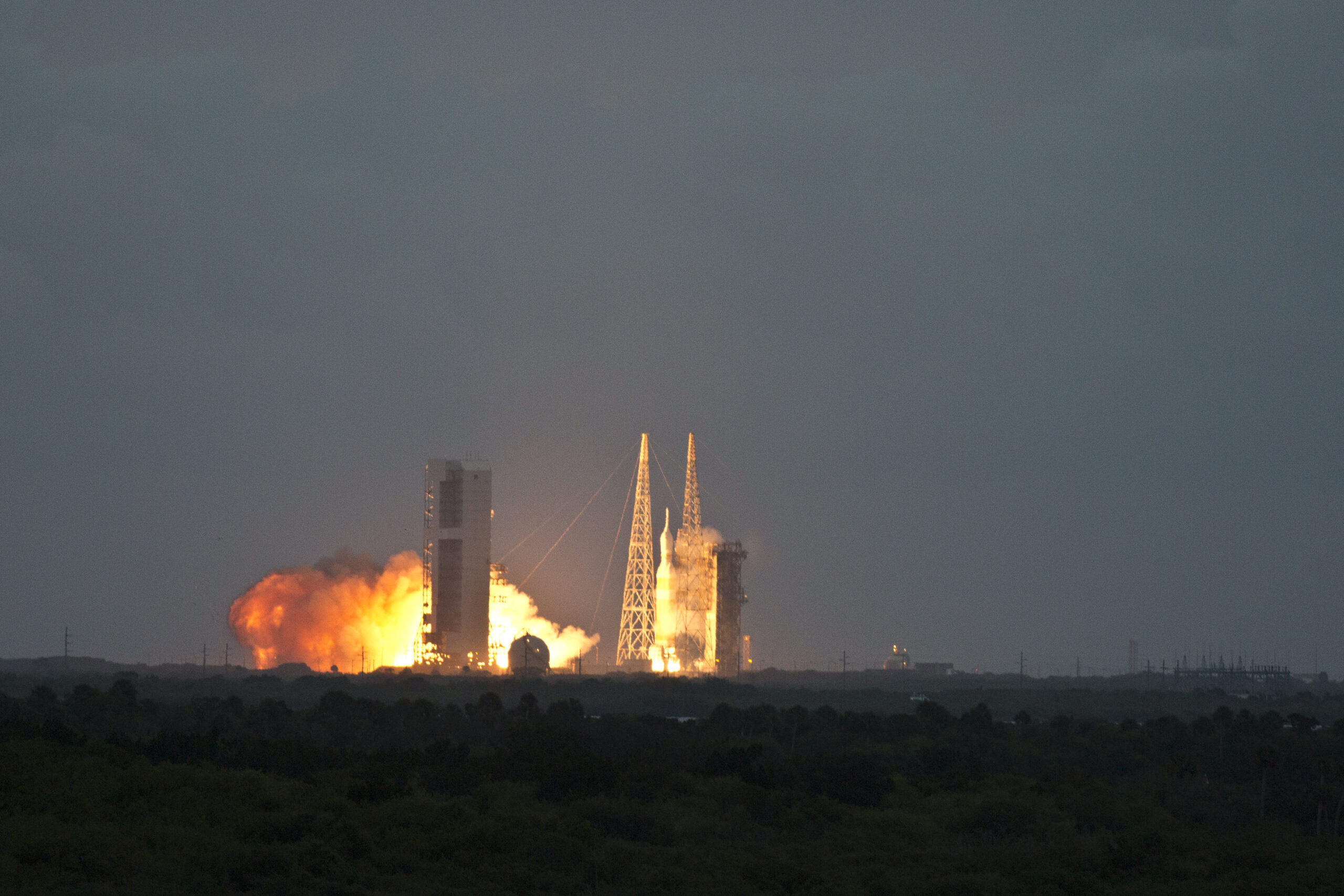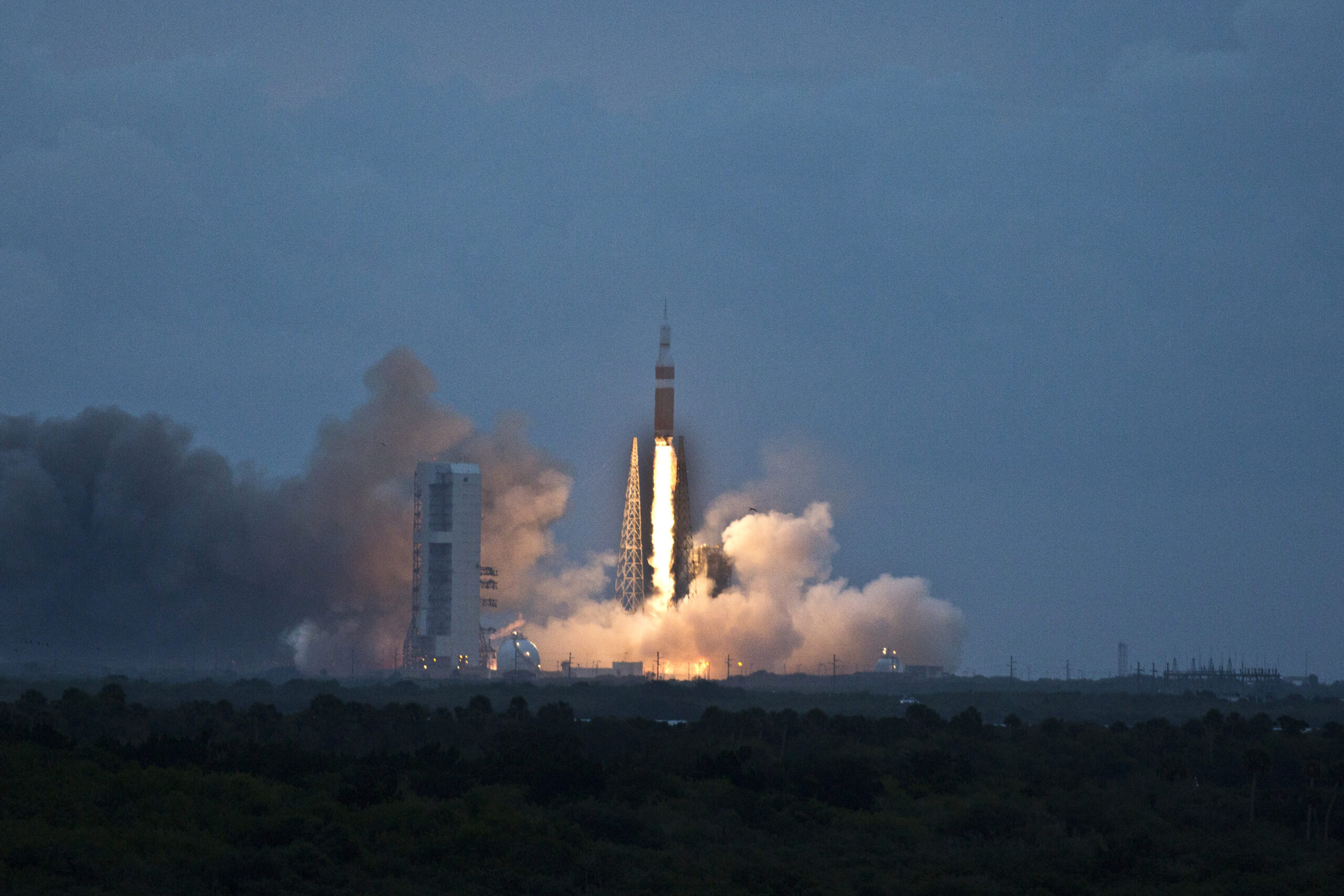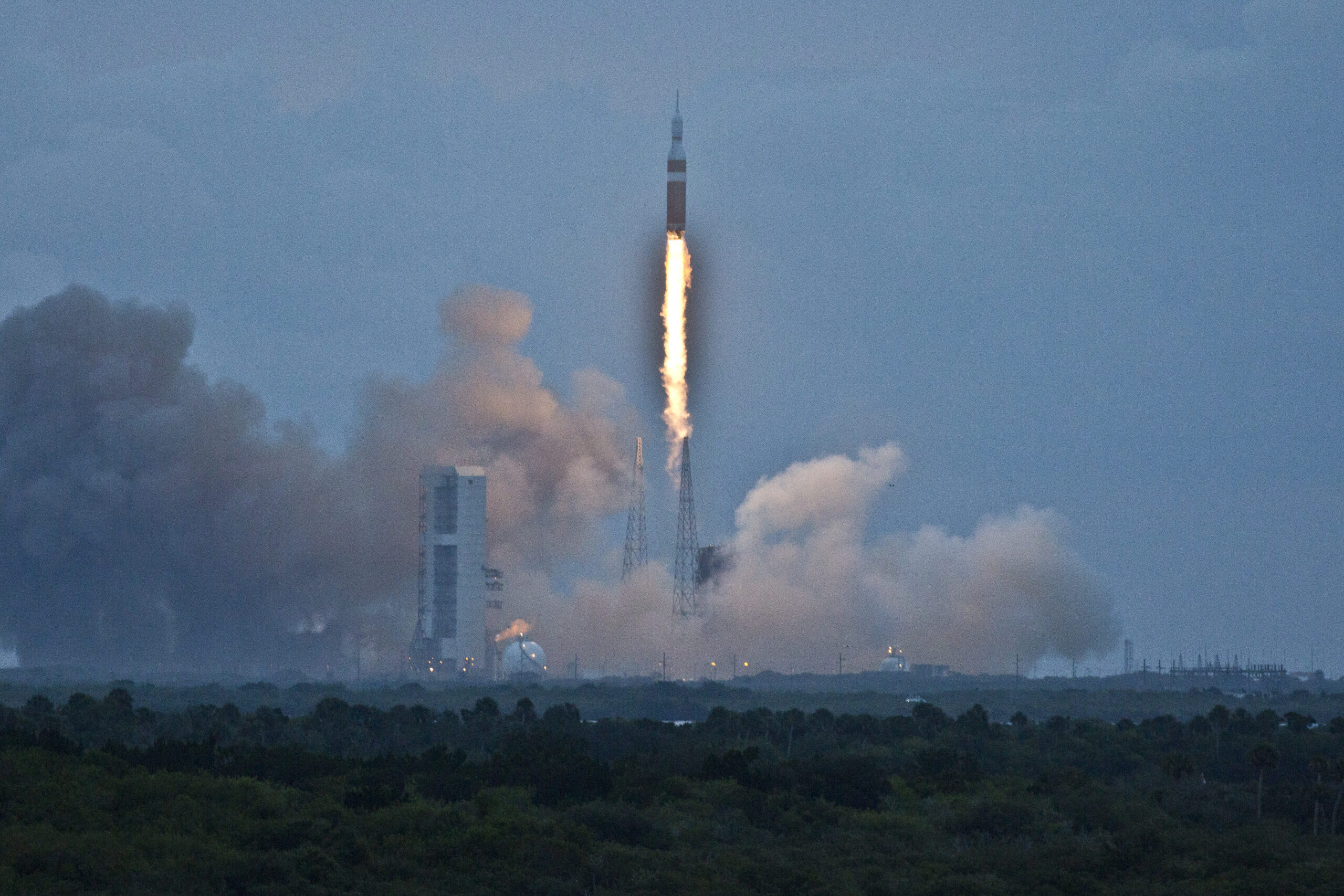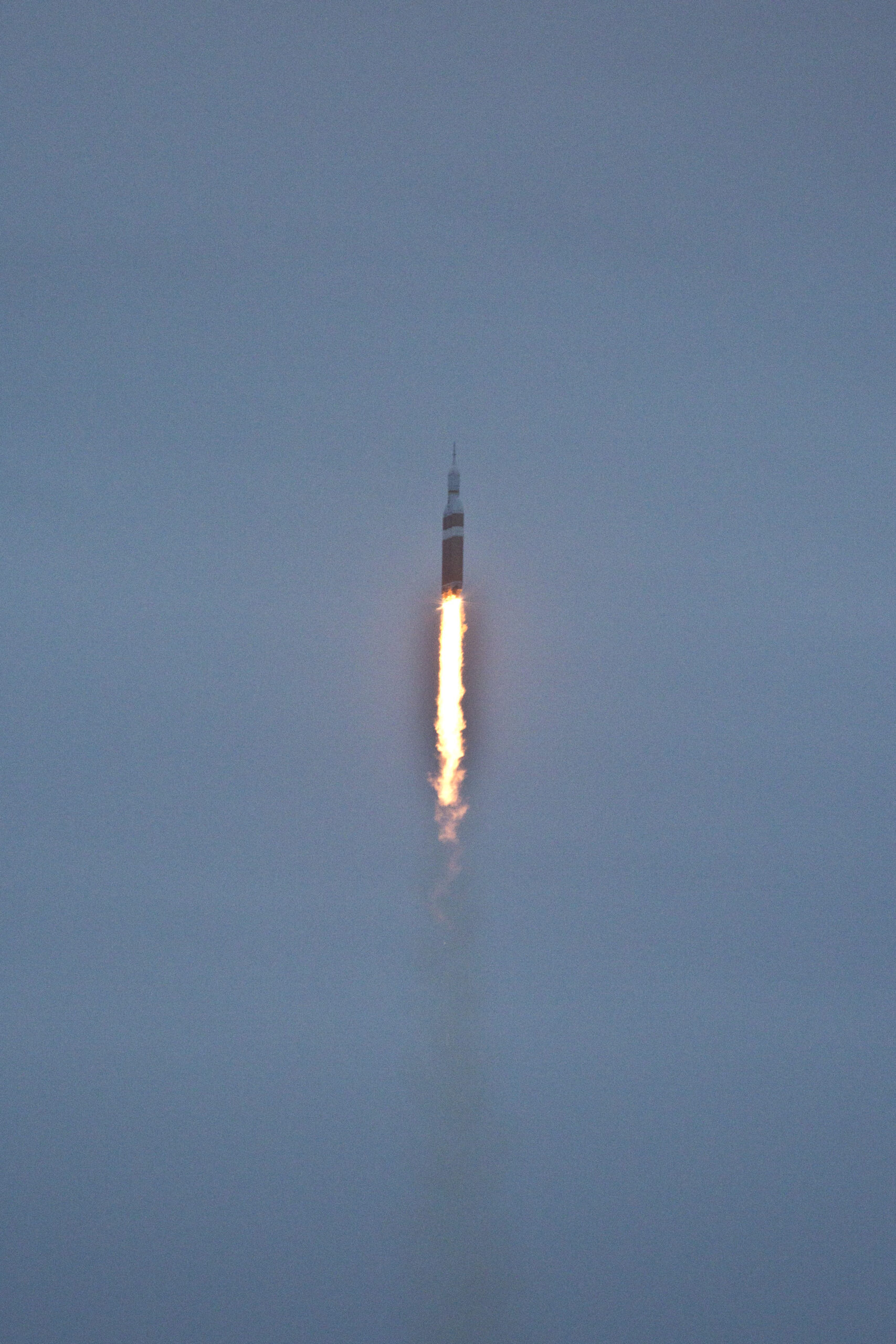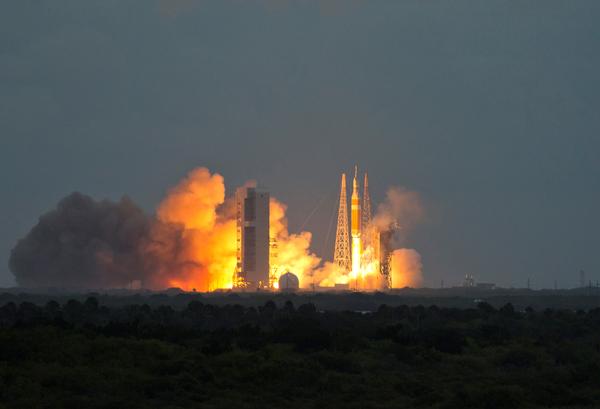
Editor’s Note:
Click here to download hi-def .mov Broll of launch,
including sound bites and actual launch footage
Thousands of Kennedy Space Center Visitor Complex guests today witnessed firsthand – only miles from the launch pad – the historic launch of the first flight of the Orion spacecraft from America’s gateway to space.
This first flight of Orion – designed to test the systems that are critical to safely sending humans into deep space, including avionics, attitude control, splashdown parachutes and the heat shield – marks the dawn of the next space exploration program, paving the way for future flights that will carry astronauts to asteroids, Mars and beyond.
Visitor Complex guests experienced the unforgettable fiery glow, thunderous roar and earth-shaking vibrations of the launch of Exploration Flight Test-1, or EFT-1, featuring the uncrewed Orion capsule aboard a 235-foot-long United Launch Alliance Delta IV Heavy rocket, one of the most powerful ever built. Many guests witnessed the launch from the Apollo/Saturn V Center and LC-39 Observation Gantry inside Kennedy Space Center.
“We came down from North Carolina a few days ago, got to spend a couple of days at the Kennedy Space Center and got to try this once yesterday,” said Eric Jnah who was visiting with his wife and two children. “There was a little bit of anticipation, but it was well worth it because today we got to see the next chapter in American history.”
Francis Mulligan of Commerce Township, Michigan who watched Orion launch with his family said, “[My son] wants to be an astronaut, that’s his dream right now, and the other two guys, well they spend their days on Kerbal Space Program launching stuff into space so this is an excellent opportunity for them to get a real close, up-front look at it.”
The rocket successfully lifted off during its second launch attempt from Space Launch Complex 37 at Cape Canaveral Air Force Station at 7:05 a.m. During the two-orbit, 4.5-hour mission, the Orion spacecraft reached an altitude of 3,600 miles into space – 15 times farther from the Earth than the International Space Station (ISS). Orion traveled farther than any vehicle designed for manned flight has gone in more than 40 years – since the Apollo moon missions.
The spacecraft re-entered the atmosphere at a speed of close to 20,000 miles per hour to test the capsule’s heat shield in withstanding temperatures of up to 4,000 degrees Fahrenheit. It then splashed down in the Pacific Ocean in a fashion similar to the Apollo moon mission capsules.
Visitor Complex guests experienced a complete pre-launch-to-post-splashdown program, including Orion-related activities and exhibits, astronaut appearances and live coverage and commentary. NASA veteran space shuttle astronauts Sam Durrance, Bruce McCandless and Mike McCulley made appearances at several locations.
“Our guests felt the rumble and experienced the excitement of the Orion launch while being part of history as we take our first steps toward Mars,” said Therrin Protze, chief operating officer of the Visitor Complex. “In addition, we offered a tremendous program of minute-to-minute information from NASA TV, astronauts and space experts.”
The Visitor Complex opened at 2 a.m. for the launch, and formal programming began at 5:30 a.m. with the Journey with Orion program hosted by John Zarrella, former CNN space expert and correspondent. It featured presentations by and guest question-and-answer sessions with mission experts and astronauts.
“This gets us back in the idea of flying, this is a human capable vehicle, it also introduces the idea of the space taxi service up to the space station that’s coming along commercially in two or three years, so we can make that transition into regular launches here from Florida again, that's quite exciting,” said former NASA astronaut Tom Jones. “Then beyond that it's the promise of going out into deep space which is really exciting for me, I want to get to an asteroid and back to the moon and to destinations like Mars.”
Beginning at 6 a.m. through the splashdown of Orion, guests viewed live NASA TV coverage of the Orion mission on giant screens throughout the Visitor Complex.”
Guests viewed special NASA, Mars and Orion interactive displays and models throughout the Visitor Complex Dec. 2-4, offering guests additional opportunities to learn more about NASA and the significance of these first steps to eventually launch astronauts to Mars.
The Orion displays – including a one-quarter-scale replica of the Orion crew capsule and EFT-1 flight pattern and Orion heat shield displays – were provided by Lockheed Martin, the prime contractor on Orion. A full-scale Orion crew capsule is also on long-term display at the Visitor Complex.
The displays also included a mock-up Mars mission space suit and Mars rover from NASA; engine and rocket models of the Space Launch System (SLS), the heavy-lift rocket being developed for NASA by ATK for future deep space missions; and Delta IV rocket and EFT-1 mission displays from United Launch Alliance.
Prior to the launch, guests saw a 150-watt, 25-millimeter green laser beam projected from the Visitor Complex to “light the way” for the launch. The laser beam was visible from throughout the Space Coast.
After launch, guests spent the day exploring Space Shuttle AtlantisSM, Exploration Space: Explorers Wanted and other attractions. The Visitor Complex is also presenting its all-new Holiday Rocket Garden Light Show daily at dusk in the majestic Rocket Garden. Through Dec. 30, guests also are treated to a stunning array of decorations, including a 41-foot Christmas tree and a giant NASA “meatball” ornament.
The launch today is one of numerous rocket launches taking place at Kennedy Space Center/Cape Canaveral Air Force Station each year, carrying not only NASA science missions and government satellites, but also testing commercial space endeavors such as SpaceX. A list of upcoming launches, launch-related activities and other special events is available online at www.KennedySpaceCenter.com/events or by calling 866-737-5235.
